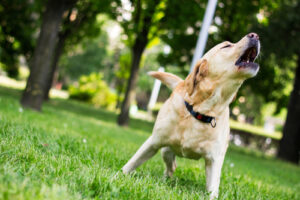Barking is normal behavior for your dog. Dogs bark to communicate with each other and with people. Still, it’s common for dogs to bark too often, or in response to stimuli that makes their barking a nuisance to their owners. You may be wondering: “Can All Dogs Unleashed stop my dog’s excessive barking?”
Absolutely, we can!
When we begin working with you and your dog, we will improve the bond between you. We will teach you to communicate clearly with your dog, use proper timing to reinforce positive behavior, and increase your dog’s ability to receive commands from you.
Each of these factors will come to play as we work on your dog’s barking problem. It’s unlikely that you’ll be able to redirect your dog without having these fundamentals in place. This is one of the many reasons that we strongly recommend that owners who are struggling with their dog’s behavioral issues first enroll in training courses, then begin retraining with proper techniques.
However, we do want to share a few tips that can be used to reduce your dog’s barking.
1. Give Your Dog Mental and Physical Interaction
Your dog needs exercise, obedience training, and play every single day.
For exercise, walking with your dog two or three times per day will be adequate for all but high-energy working breeds. These specialized dogs have been bred to have incredible stamina and high intelligence and require fitness and obedience routines to suit their needs.
After you have taken your dog on one of your walks and offered water, it’s time to break out the treats and run through an obedience routine. Your dog will be calm, happy, and therefore best prepared to engage with you.
2. Offer Toys
Once your dog has completed both exercise and obedience training, you may offer a chew toy, ball, or plush toy, depending on your dog’s preference. After you’ve had time to focus on your own goals for a while, loop back and spend a few minutes playing with your dog. Throw the ball, play tug-of-war with a rope toy, or make the stuffed toy “come alive.”
This type of routine will leave your dog focused on paying attention to your actions rather than keeping its ears perked for an opportunity to bark.
3. Never Reinforce Barking
The knee-jerk reaction from many owners is to yell or call their dog’s name when the barking starts. But what exactly does this teach a dog?
“It was boring. Then I heard something exciting, I barked, and then my owner(s) joined in the excitement! This is way better than sitting quietly.”
The dog has only learned that barking is fun, entertaining, and a guaranteed way to earn attention from you!
The way out of this loop is to anticipate your dog’s barking and offer preemptive praise for silence. For example, if you know your dog barks at the mail carrier, have a pouch of high value treats on your person when you expect the mail to arrive. When your dog perks up at the sound of the mail truck, but before the barking begins, praise your dog for being quiet and offer a treat.
Continue this back and forth every ten seconds. If your dog begins to bark, instantly turn your back, put the treats away, and walk away. Do not correct your dog, and do not interact with your dog.
If your dog falls silent right away, turn back to face him, offer praise, and give a treat. If your dog continues to bark, you must not react. Over time, your dog will deduce that being quiet means praise and delicious snacks, while barking is a boring dead-end.
If your dog barks when you let them out into the backyard, spend time outside with them. Listen for a neighbor’s dog barking, look for squirrels running by, or any other stimuli that prompts your dog to bark. Just like in our mail carrier example, your job will be to take advantage of that split second opportunity after your dog registers the stimuli, but before the barking begins. At this critical moment, you’ll offer treats and praise for being quiet.
4. Teach Your Dog to Bark on Command
Now that you are only listening to your dog barking when it’s intended to communicate with you, it’s a great opportunity to teach your dog to bark on command. This will solidify your dog’s concept of barking as something that should happen for specific reasons, at specific times.
Once we’ve worked with you and your dog and taught you how to elicit barking on command, you can incorporate barking into your dog’s daily obedience training regimen. This will allow your dog to use barking for fun, entertaining activities—which is likely what she was going for in the first place!
A Final Note
If there’s one thing we know about training dogs, it’s that yelling, hitting, shoving, or intimidating your dog will not improve their relationship with you, their ability to be obedient, or their confidence to respond well to new training.
While it can be frustrating to have a dog who barks at everything (or seemingly nothing), it’s vital that you stop using any of these ineffective methods.
Instead, please contact us today. We invite you and your canine to work with our All Dogs Unleashed team to learn powerful positive training methods that will transform your dog into an enjoyable, obedient companion animal.




